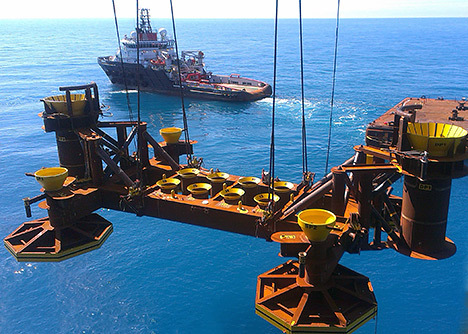
Europe’s oil industry is once again generating cash even as crude languishes at half the price of three years ago. Yet companies remain vulnerable to a renewed downturn.
The region’s top three — Royal Dutch Shell Plc, Total SA and BP Plc — can now cover spending from cash flow with oil at $50 a barrel. But BP predicts prices will drop this year, while Shell talks of a “ lower forever” view. A fresh slump could put dividends at risk, and investors know it.
Energy stocks are the worst performers in the MSCI World Index this year, with the 89 companies in the industry losing more than $150 billion in market value. High dividend yields — a signal that shareholders fear a cut in payouts — have dogged oil producers, turning some investors away from the sector.
“For a lot of people it is currently in the ‘too-difficult’ box –- many people are still bearish on oil prices,” said Rohan Murphy, an analyst at Allianz Global Investors, which owns shares in Shell, Total and BP. “A general comment I hear is that the yield is telling you the dividend is unsustainable and these companies can’t really have changed that much.”
Shell’s dividend yield, the annual return divided by the share price, rose to the highest in more than a year last month. It was at 6.9 percent on Tuesday. BP’s yield, which has stayed near 7 percent this year, dropped to 6.6 percent after the company said it’s able to cover payouts with cash from operations.
“The market is trying to understand the robustness of each of the individual businesses to where the oil price is today,” BP Chief Financial Officer Brian Gilvary said in an interview. “The market is slightly concerned right now around the sustainability for all of the businesses.”
Benchmark Brent is trading around $52 a barrel, compared with more than $100 three years ago. Gilvary said prices will “drift back down” toward $50 by the end of 2017 and be “somewhere around $45 to $55” in 2018.
BP covered its cash dividend and capital spending in the first half of the year at $47 a barrel. Shell also financed shareholder payouts and investments out of cash flow, and used surplus funds to reduce debt. Yet the shares of both companies have dropped this year, by about 10 percent and 8 percent, respectively.
“In terms of the share price, at a 7 percent dividend yield, I do feel the 7 percent is high,” Shell Chief Executive Officer Ben Van Beurden told reporters July 27. “Not because the dividend is too high but because the share price is too low.” The removal of the scrip dividend — or payout in stock — will be a catalyst to drive the shares higher because it will show confidence, he said.
European oil companies, all of which made sweeping cost cuts amid oil’s collapse, have signaled a return to growth with earnings above analyst expectations. Shell generated almost as much cash from operations in the second quarter as it did when crude was above $100. Still, many are relying on disposals and scrip dividends to free up funds. BP has been forced to sell billions of dollars of assets to pay penalties following the 2010 Gulf of Mexico oil spill.
On Tuesday the U.K. company reported net debt of almost $40 billion, but said diminishing payments for the spill, new projects and stronger cash will help drive its shares higher.
BP’s “balance sheet has waning capacity to sustain a near-term oil price decline, emphasizing the necessity for timely delivery of project startups and divestment progress, both weighted to the second half,” Will Hares, an energy analyst at Bloomberg Intelligence in London, said in a note.
With crude prices down about 9 percent this year, all the oil majors have said they’ll keep a tight rein on spending, even as acquisitions start to return.
“It’s a tough environment and could remain that way for some time,” BP boss Bob Dudley said Tuesday. “Thinking about $50 oil for the next five years is the numbers we’re going to use right now, and keep the discipline about it. That’ll bring down the cost structures even further in the industry.”
Recommended for you
